Did you know that Muscovy ducks aren’t true ducks? Yes! The Muscovy duck is genetically distinct from all other domestic ducks.
How did this happen? These ducks are genetically separate from Mallards, from whom all other domestic duck breeds originate.
The Muscovy duck is also known as a Barbary duck or a French duck, depending on where it is from. The Muscovy duck resembles a small goose thanks to its long neck and large body size.
The meat of these birds is highly prized for its rich flavor. The fullness of taste in Muscovy duck meat is often compared to that of roast beef.
If you’re a duck lover, a chef seeking high-quality meat, or a subsistence farmer, this article will brief you on everything you need to know about Muscovy ducks. So, let’s get started.

Table of Contents
Muscovy Duck Breed Key Information
| Male Weight: | 10–15 lbs. |
| Female Weight: | 6.0–7.9 lbs. |
| Breed Class: | Heavy |
| Use: | Dual-purpose, for both meat and eggs |
| Egg Size: | Large |
| Egg Production: | 180 per year |
| Lifespan: | Up to 20 years |
| Climate Tolerance: | Hardy |
| Color: | Black and white, chocolate and white, blue |
| Temperament: | Docile |
| Flying Ability: | Good flyers |
| Beginner friendly: | Yes |
History of the Muscovy Duck Breed
Their Name
These birds have been around for hundreds of years. Could the name hold the key to their origin? Let’s see.
The word “Muscovy” may lead you to believe that the duck was first seen in Moscow. However, that is not the case.
The other name for this duck, Barbary duck or Canard de Barbarie in French, makes it sound like it comes from the Barbary coast of North Africa between Gibraltar and Egypt, which, again, it does not.
Unfortunately, it’s not the ideal strategy to use the name as the hook for this avian origin story.
All around the world, people call this common bird a wide range of names.
Interestingly, Muscovy duck breeds are even called Musco. And this is mainly because they enjoy eating a lot of mosquitoes.
The Origin
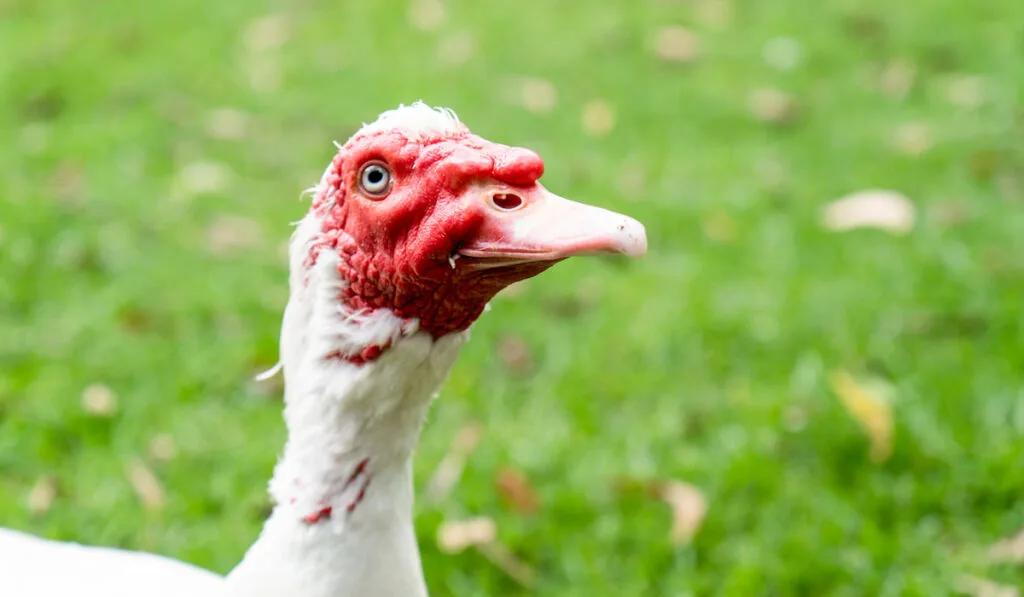
Muscovy ducks are a New World native species that were domesticated long before Europeans arrived.
Furthermore, the Muscovite Company, which traded this duck in the 1500s, is a likely source of the name “Muscovy duck.”
The Muscovy Duck Is Not a True Duck
The Muscovy duck is an extraordinary variety of waterfowl. The Muscovy is commonly referred to as a duck, but it is not a true duck.
As a matter of fact, it’s just a distant relative of ducks. Almost all domestic ducks are related to the Mallard, but not the Muscovy duck.
And it’s a good bet that the Mallard duck is just as closely related to geese as it is to ducks.
Scientifically speaking, Muscovy ducks are classified as Cairina moschata, whereas Mallards are Anas platyrhynchos and their derivative domestic breeds are Anas platyrhynchos domesticus.
Breeding Standards
In 1874, they were added to the American Poultry Association’s Standard of Perfection for the first time.
The American Poultry Association has recognized the following:
- White
- Black
- Blue
- Chocolate
The Muscovy duck has grown in popularity over the past few decades and is now commonly maintained as a backyard bird around the globe.
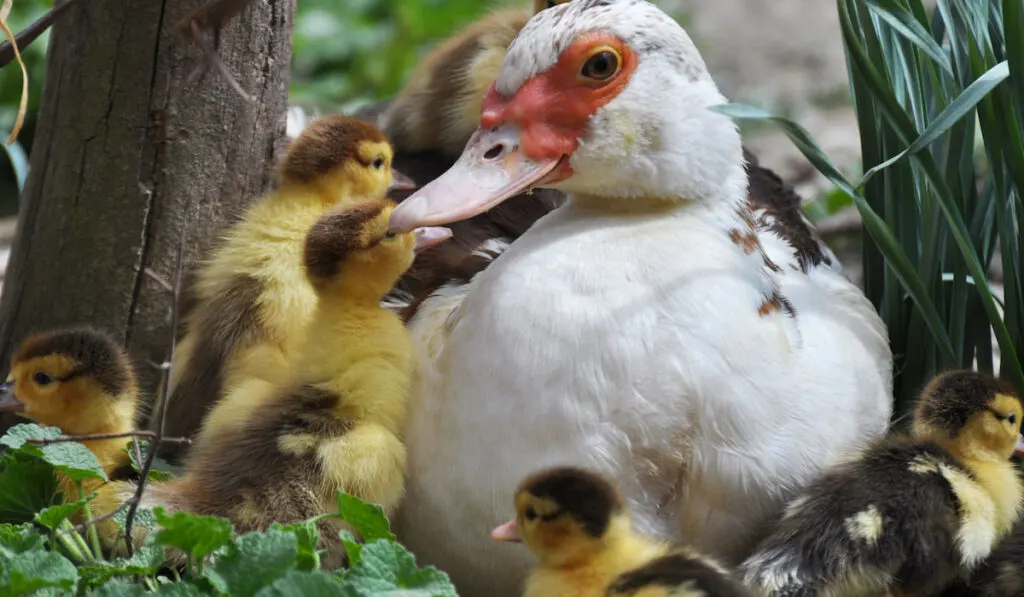
Muscovy Duck: A Source of Eggs
Muscovy ducks lay around 180 eggs per year, and this number can be increased by providing the females with a diet high in protein and other essential nutrients.
The flavor and richness of Muscovy eggs cannot be beaten. They weigh about 2.7 ounces, making them “jumbo,” and have a cream hue with a tougher shell than other duck eggs.
Muscovy hens often begin laying at the six-month mark. However, the diet you provide your Muscovy hens can affect how long it takes for certain birds to start laying.
Muscovy Duck Meat
Meat from Muscovy ducks is one of Europe’s most beloved and extensively consumed duck meats.
Because of the lean texture and mild flavor, the meat of Muscovy ducks is quite excellent.
In addition, Muscovy duck meat has thin skin, is low in fat, and has a rich red color with a slight hint of game.
Its tenderness is typically compared to that of veal, and its flavor to that of roast beef.
Muscovy duck meat can taste fantastic if seasoned before roasting or slow cooking; this brings out the natural flavor and makes for a delicious meal.
You can also enjoy the meat of these ducks on the grill.
When cooked, it is soft and versatile, making it ideal for dishes such as stews.
Muscovy ducks also have bigger breasts than other ducks. And for many of us, this is our favorite part of the duck to eat.
But keep in mind that Muscovy ducks take longer to reach maturity than other types of meat ducks.
While Muscovy ducks usually take around 20 weeks to reach slaughter size, Peking ducks can be harvested in as little as 7 weeks.
Also, because this duck is quite big, it needs more food, which makes it more expensive to keep.

Muscovy Ducks and Pest Control
Muscovy ducks are a fantastic natural way for reducing farm insect pests.
Some of the pests that can be effectively eliminated with their help are snails, slugs, insect larvae, flies, grasshoppers, and ticks. Full-grown Muscovies have even been observed eating mice.
Mosquitoes and their larvae are among the most beloved foods of the Muscovy duck.
The presence of these ducks in pens with cows or calves has been shown to greatly reduce the number of flies in the area.
When two-year-old Muscovy ducks were placed into cow pens, the number of flies dropped by 80% to 90%.
Typical Traits of Muscovy Duck
The Muscovy duck is a heavyweight duck. It is a huge bird with a wingspan of up to 64 inches.
Domestic drakes of Muscovy ducks are roughly twice the size of hens. However, both sexes are quite large, with males weighing 15 pounds and females weighing 6–7 pounds.
Muscovy ducks are most easily identified by their caruncles, the rough black or red skin growths on their faces.
In addition to its great size and white patterns on its black plumage, this duck is distinguished by its narrow crest that curves over its forehead and its large talons that finish with sharp claws.
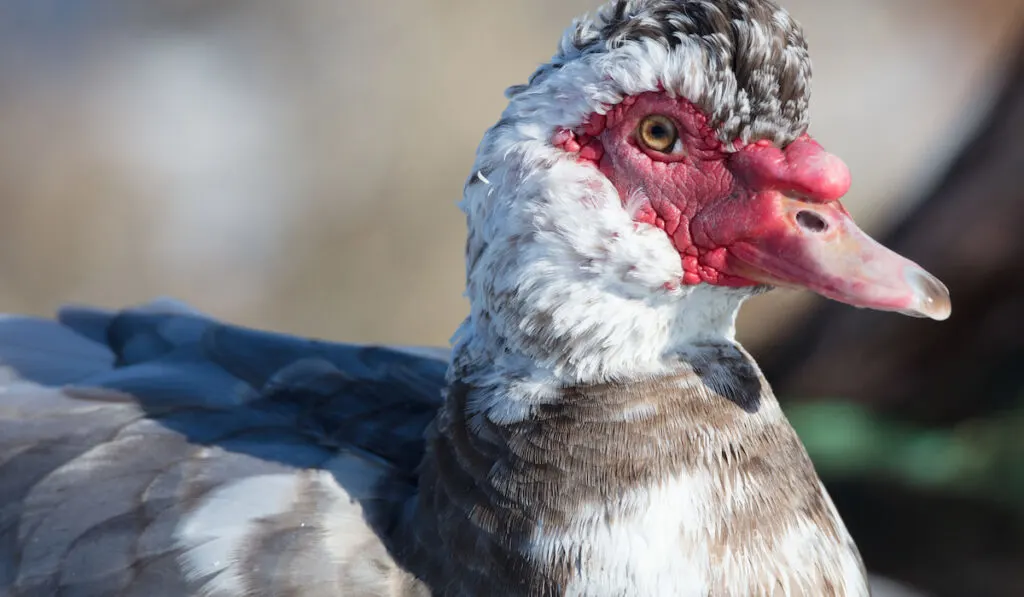
Size and Weight
Muscovy ducks are huge, heavy-bodied ducks with long necks that give them the appearance of little geese.
Muscovy duck drake (domestic):
- length is about 34 in
- weight is 10–15 lbs.
Muscovy duck hen (domestic):
- length is about 25 in
- weight is 6.0–7.9 lbs.
Wild Muscovy Duck
The wild Muscovy duck is mostly black but has white patches on its wings. All the Muscovy ducks we know today are descendants of the original wild variety.
While the wild drake’s head has a short crest, its bill is black with a few pale pink spots on it.
You can also see a blackish or dark red knob at the base of the bill, and the bare skin on his face is also dark.
The wild drakes have blackish legs and webbed feet, and their eyes are yellowish-brown.
While the female ducks in the wild look the same, they are much smaller. They don’t have a big knob on top, and their faces are feathered.
The young bird in the wild is duller all over, and the upper wing has little or no white.
Domesticated Muscovy Duck
Modern domestic Muscovy ducks are quite close to their wild ancestors in appearance.
Modern domesticated Muscovy ducks are either black or dark brown with white spots, especially on their heads. They also develop other colors, like lavender or all-white.
Both drakes and ducks raised in a domestic environment have a bare face, either all red or black and red.
The drakes have a low crest that stands straight up and large caruncles at the base of their bills.
The bill is flat and can be any combination of yellow, pink, or black. It can also have “spots” that are pink.
The long claws on the Muscovy’s webbed feet make them stand out.
Domestic Muscovy ducks come in many colors, such as black, blue, bronze, chocolate, lavender, pied, ripple, white, and many other pastel colors.

Muscovy Ducklings Raised Domestically
Domestic Muscovy ducklings are mostly yellow, with buff-brown spots on the tail and wings.
Some also have dark heads and blue eyes, while others have dark markings on their napes and a light brown crown.
Muscovy Duck Mom
When nesting, Muscovy hens prefer to do it on the ground, in an isolated, protected spot away from the rest of the flock.
Before sitting, a Muscovy duck hen can lay between ten and twenty eggs. She will then sit on the eggs until the ducklings hatch.
The mothers of Muscovy ducks are particularly unique due to the fact that they frequently help in the process of hatching eggs or raising young ducklings for each other.
Muscovy hens may share nesting duties even with chicken moms.
Muscovy duck eggs require approximately 35 days to hatch. After the ducklings’ hatch, the hen brings them back to the flock area.
When it comes to raising their young, Muscovy duck mothers are second to none.
Muscovy Offspring
The offspring of a Muscovy duck and a Mallard duck mix is called a Mule duck or a Mulard or Moulard.
The Mule duck is sterile, so it cannot be reproduced. However, it makes for excellent meat and has a reputation for having exceptional flavor.
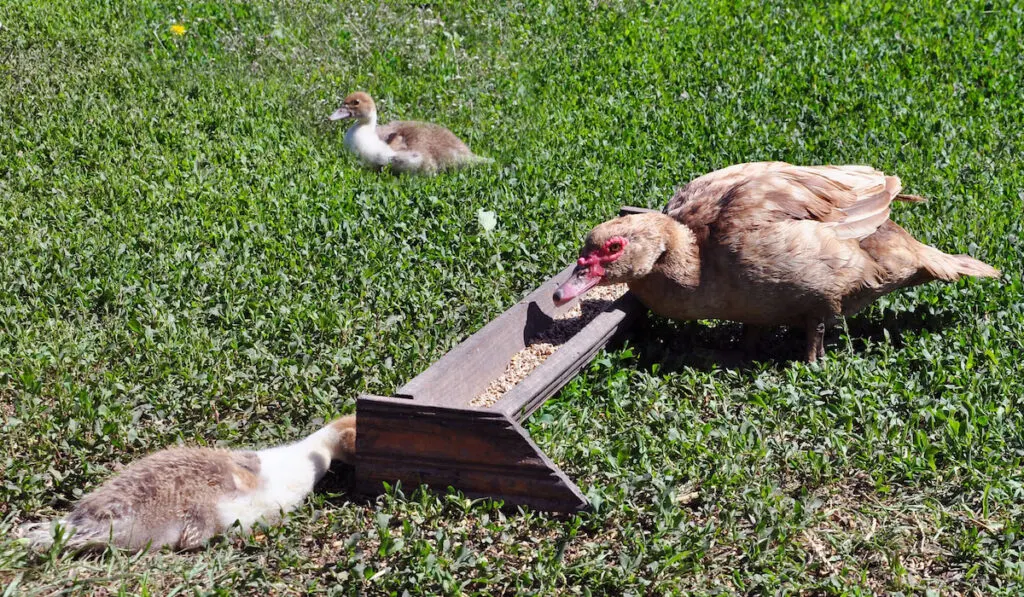
Feeding
Muscovy ducks like to live and forage in places with plenty of vegetation to eat a wide range of healthy foods.
Their diet consists of plants, leaves, roots, bugs, crustaceans, small fish, and even small reptiles in these areas.
The best way to make sure that your Muscovy ducks get all the nutrients they need is to let them roam free.
Even if these ducks are free to look for food on their own, they will still need your help to get the daily nutrition they require to remain healthy.
You can feed them a 28% game bird starter when they are young. As they get older and start laying eggs, you can gradually switch them to a 20% layer feed.
Between the food you feed them and what they find while foraging, your ducks will remain happy and healthy.
And you can always give them treats like mealworms, cracked corn, and fresh greens.
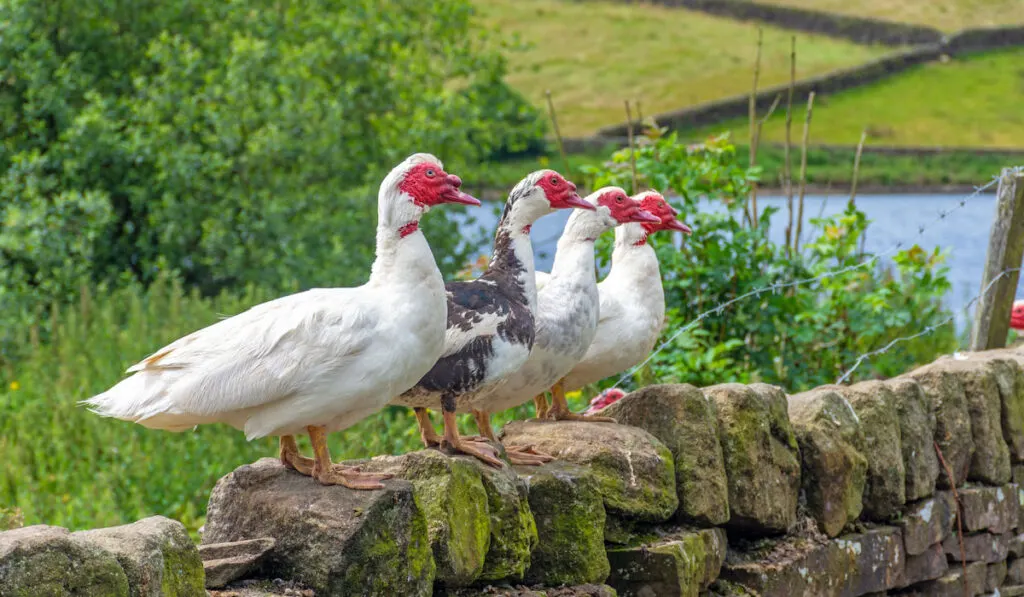
How Loud Is the Muscovy Duck?
Most of the time, Muscovy Ducks are quiet.
They don’t make the “quack” sound that you often associate with most ducks, but that doesn’t mean they can’t make any noise at all.
When a female is scared or wants to communicate with her ducklings, she makes a delicate shrill sound. But drakes hiss and puff, especially during courtship.
Health and Care
Muscovy ducks thrive in warm climates, but it seems that they are equally as content in cold temperatures as low as 0°F (-17.7°C).
If given adequate room and protected against predators, Muscovy ducks can pretty much take care of themselves.
If they don’t have a large area to forage, you should give them duck feed to ensure they remain healthy.
In general, the Muscovy duck is strong and healthy but has one health issue. It is more likely to be infected with the tropical parasites Haemoproteus and Plasmodium.
However, neither parasite is dangerous to humans because it can’t be spread from animals to people.
Apart from that, they only have to deal with usual common pests, like lice and worms, but these can be controlled with medicines and vaccines.
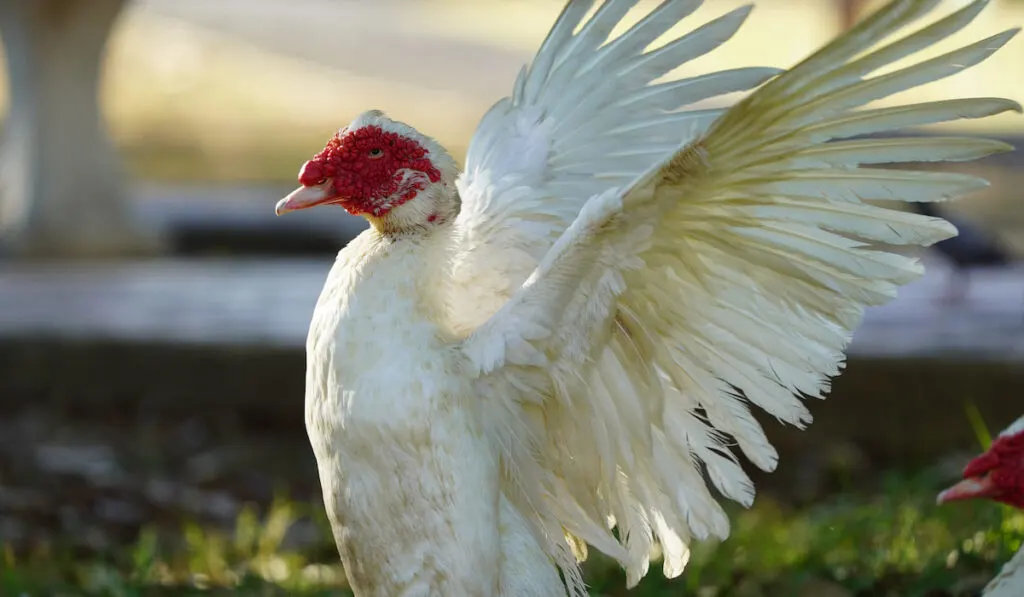
Muscovy Duck Flying Abilities
Muscovies have been a domestic breed for a long time, but they still share many similarities with their wild ancestors.
Thanks to this, they have instincts and skills that help them survive, like being able to fly.
Most domestic Muscovy ducks are ideal because they can’t fly for more than a few seconds, but many Muscovies can still fly.
In fact, they like to sleep in trees because that’s where they feel most at home. Their feet have strong, sharp claws, perfect to grip and perch on branches.
When you try to keep them fenced in, they may decide to fly away, but you can prevent this by trimming one wing. They are less likely to fly as a result because it throws off their balance.
Muscovy Duck Personality
Each Muscovy duck seems to have its own character, but they all have certain things in common.
While they are known for being friendly and calm, they don’t like to be touched, even if they know you are a source of food.
Muscovy ducks can be friendly to people and other animals, but they can also act aggressively.
They don’t defend territories, but they might attack other ducks at any time of the year, especially when females are nesting.
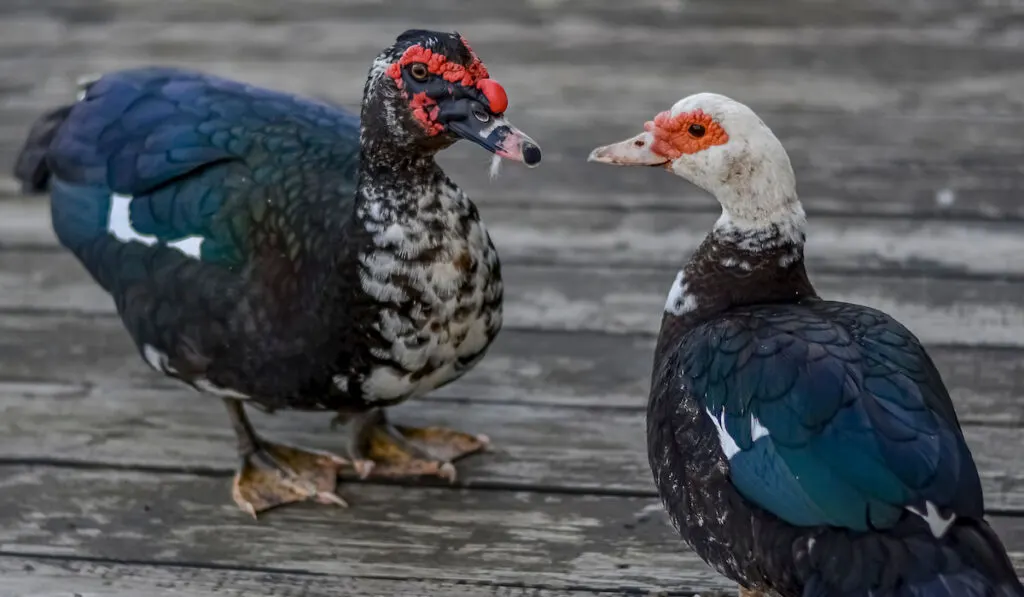
Muscovy Duck Chick-Sexing
Vent-sexing is the most effective way to tell the sex of Muscovy ducklings. During this process, the duckling is turned over, and the orifice below its tail is examined.
While wearing gloves and prepping the vent with a tiny quantity of petroleum jelly, the male duck’s penis may be unwrapped by applying pressure below and to the sides of the vent.
Improper vent-sexing will result in an injured duckling.
Male ducklings will be larger than female ducklings at around four weeks and have thicker legs and larger feet.
While mature males are almost twice as large as the hens, they can also be distinguished by their greater chest-to-tail proportion.
Final Thoughts
Being a well-known breed with many interesting characteristics, Muscovy ducks are the perfect option for anyone wishing to have their own flock.
The Muscovy duck offers a lot in terms of egg production and meat, but they are also excellent foragers, so pest management on your property is a nice bonus.
They blend in seamlessly with chickens and other birds, they are low maintenance, and they don’t make much noise when compared to other duck breeds.
Resources
- https://en.wikipedia.org/wiki/Domestic_Muscovy_duck
- https://www.riverviewparkandzoo.ca/en/zoo/muscovy-duck.aspx
- https://www.waterfowl.org.uk/domestic-waterfowl/muscovy-ducks/
- https://amerpoultryassn.com/2022/05/the-muscovy-duck/
- https://www.roysfarm.com/muscovy-duck/
- https://www.chickensandmore.com/muscovy-duck/
- http://www.moosemanorfarms.com/about-muscovy-ducks.html
- https://www.tandfonline.com/doi/full/10.1080/09712119.2021.1895173
